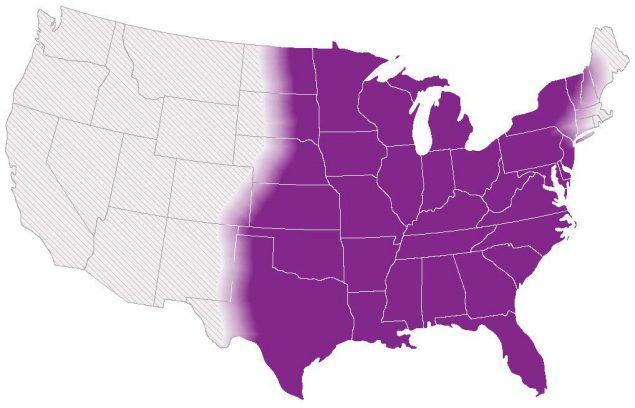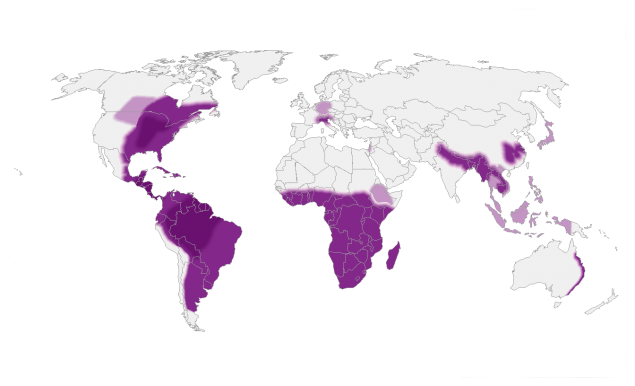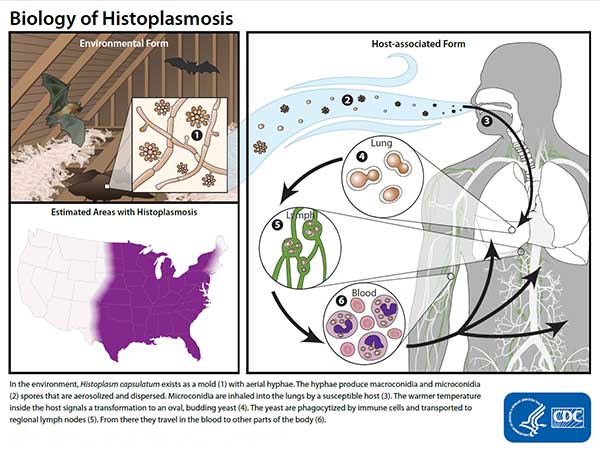Where Histoplasmosis Comes From
Where does Histoplasma live?
Histoplasma, the fungus that causes histoplasmosis, lives throughout the world, but it’s most common in North America and Central America. In the United States, Histoplasma mainly lives in soil in the central and eastern states, particularly areas around the Ohio and Mississippi River Valleys, 1 but it can likely live in other parts of the country as well. 2 The fungus also lives in parts of Central and South America, 3 Africa, 4 Asia, 5 and Australia. 6
These maps show CDC’s current estimate of where the fungi that cause histoplasmosis live in the environment. These fungi are not distributed evenly in the shaded areas, might not be present everywhere in the shaded areas, and can also be outside the shaded areas. Darker shading shows areas where Histoplasma is more likely to live. Diagonal shading shows the potential range of Histoplasma.


Life cycle of Histoplasma
Histoplasma spores circulate in the air after contaminated soil is disturbed. The spores are too small to see without a microscope. When people breathe in the spores, they are at risk for developing histoplasmosis. After the spores enter the lungs, the person’s body temperature allows the spores to transform into yeast. The yeast can then travel to lymph nodes and can spread to other parts of the body through the bloodstream.
Click here for the PDF version of image for printing pdf icon[PDF – 248 KB].

- Manos NE, Ferebee SH, Kerschbaum WF. Geographic variation in the prevalence of histoplasmin sensitivityexternal icon. Dis Chest. 1956 Jun;29(6):649-68.
- CDC. Histoplasmosis in a state where it is not known to be endemic–Montana, 2012-2013. MMWR Morb Mortal Wkly Rep. 2013 Oct 25;62(42):834-7.
- Colombo AL, Tobon A, Restrepo A, Queiroz-Telles F, Nucci M. Epidemiology of endemic systemic fungal infections in Latin Americaexternal icon. Med Mycol. 2011 Nov;49(8):785-98.
- Loulergue P, Bastides F, Baudouin V, Chandenier J, Mariani-Kurkdjian P, Dupont B, et al. Literature review and case histories of Histoplasma capsulatum duboisii infections in HIV-infected patientsexternal icon. Emerg Infect Dis. 2007 Nov;13(11):1647-52.
- Chakrabarti A, Slavin MA. Endemic fungal infections in the Asia-Pacific regionexternal icon. Med Mycol. 2011 May;49(4):337-44.
- McLeod DS, Mortimer RH, Perry-Keene DA, Allworth A, Woods ML, Perry-Keene J, et al. Histoplasmosis in Australia: report of 16 cases and literature reviewexternal icon. Medicine. 2011 Jan;90(1):61-8.
- DiSalvo A. The role of bats in the ecology of Histoplasma capsulatum. In: Ajello L CE, Furcolow ML, editors. Histoplasmosis: proceedings of the second national conference; 1971; Springfield, IL; 1971. p. 149–61.